Strategic Quality and System Management: ISO 22000 Research Project
VerifiedAdded on 2023/04/21
|17
|4632
|391
Project
AI Summary
This research project, focusing on strategic quality and system management, investigates the role and effectiveness of ISO 22000 in the food industry. It explores the background of ISO 22000, developed by the International Organization for Standardization (ISO), and its implementation to enhance food safety management systems. The project addresses the issues of food safety before ISO 22000:2005 implementation, highlighting the impact of contamination and poor ingredients, and examines the standard's effectiveness in reducing food hazards. The research includes a literature review on the benefits of ISO 22000, its impact on food security, and the recommended actions for organizations to adhere to the standard. The project aims to identify ISO 22000's requirements for food safety, evaluate its effectiveness in avoiding food hazards, and determine recommended actions for organizations, with a focus on case studies in Cyprus. The research methodology includes a detailed time horizon, sample selection, data collection, and data analysis to ensure a comprehensive understanding of ISO 22000's role in ensuring food safety and quality.
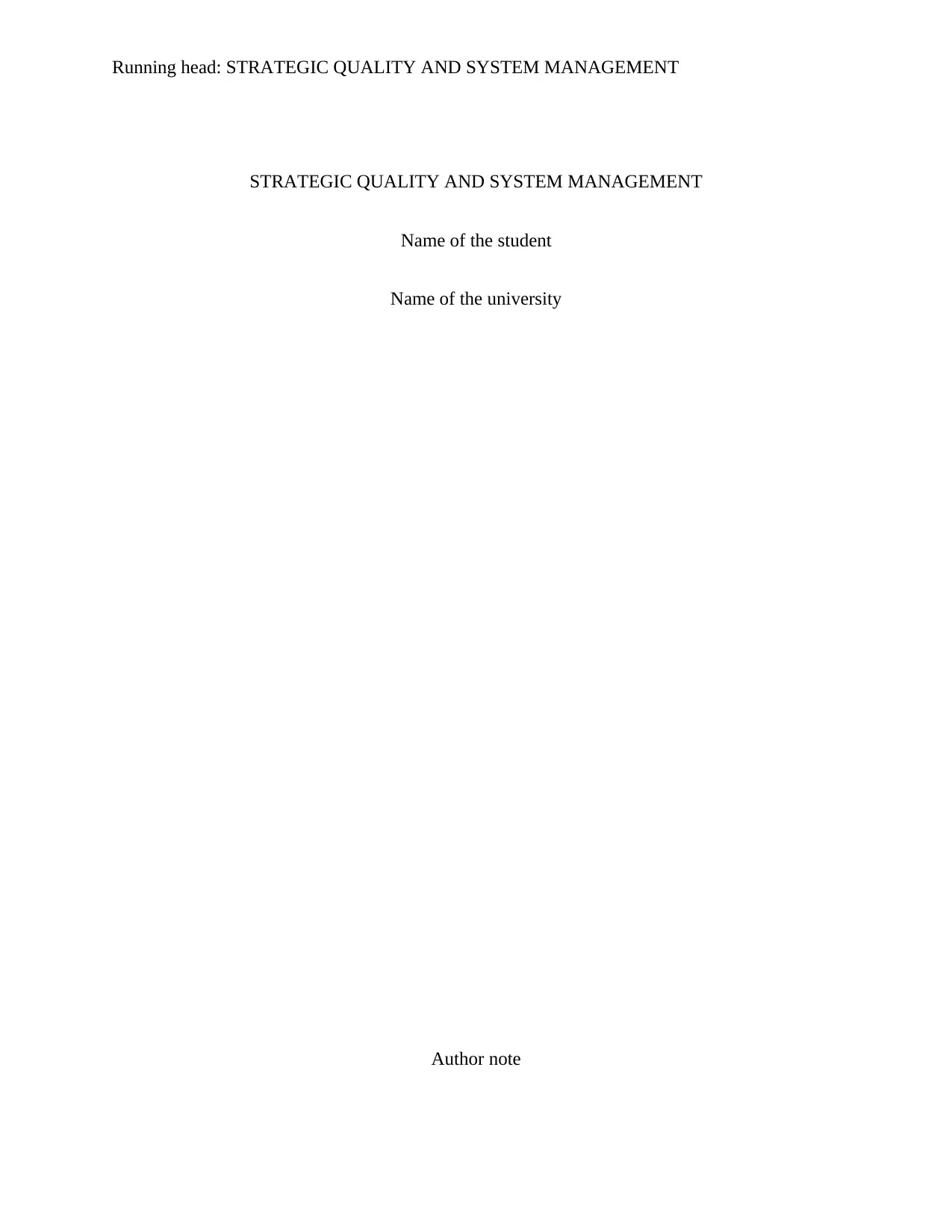
Running head: STRATEGIC QUALITY AND SYSTEM MANAGEMENT
STRATEGIC QUALITY AND SYSTEM MANAGEMENT
Name of the student
Name of the university
Author note
STRATEGIC QUALITY AND SYSTEM MANAGEMENT
Name of the student
Name of the university
Author note
Paraphrase This Document
Need a fresh take? Get an instant paraphrase of this document with our AI Paraphraser
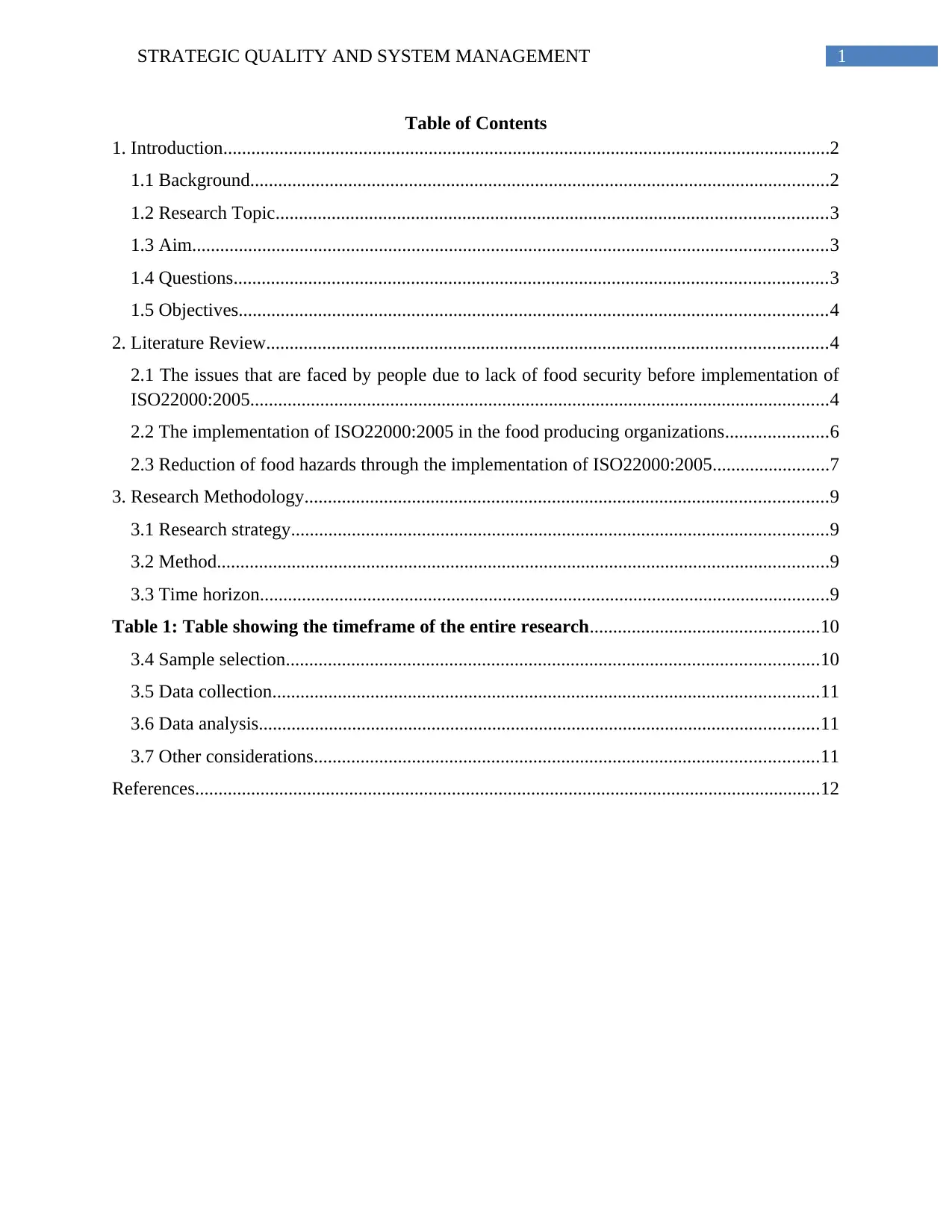
1STRATEGIC QUALITY AND SYSTEM MANAGEMENT
Table of Contents
1. Introduction..................................................................................................................................2
1.1 Background............................................................................................................................2
1.2 Research Topic......................................................................................................................3
1.3 Aim........................................................................................................................................3
1.4 Questions...............................................................................................................................3
1.5 Objectives..............................................................................................................................4
2. Literature Review........................................................................................................................4
2.1 The issues that are faced by people due to lack of food security before implementation of
ISO22000:2005............................................................................................................................4
2.2 The implementation of ISO22000:2005 in the food producing organizations......................6
2.3 Reduction of food hazards through the implementation of ISO22000:2005.........................7
3. Research Methodology................................................................................................................9
3.1 Research strategy...................................................................................................................9
3.2 Method...................................................................................................................................9
3.3 Time horizon..........................................................................................................................9
Table 1: Table showing the timeframe of the entire research.................................................10
3.4 Sample selection..................................................................................................................10
3.5 Data collection.....................................................................................................................11
3.6 Data analysis........................................................................................................................11
3.7 Other considerations............................................................................................................11
References......................................................................................................................................12
Table of Contents
1. Introduction..................................................................................................................................2
1.1 Background............................................................................................................................2
1.2 Research Topic......................................................................................................................3
1.3 Aim........................................................................................................................................3
1.4 Questions...............................................................................................................................3
1.5 Objectives..............................................................................................................................4
2. Literature Review........................................................................................................................4
2.1 The issues that are faced by people due to lack of food security before implementation of
ISO22000:2005............................................................................................................................4
2.2 The implementation of ISO22000:2005 in the food producing organizations......................6
2.3 Reduction of food hazards through the implementation of ISO22000:2005.........................7
3. Research Methodology................................................................................................................9
3.1 Research strategy...................................................................................................................9
3.2 Method...................................................................................................................................9
3.3 Time horizon..........................................................................................................................9
Table 1: Table showing the timeframe of the entire research.................................................10
3.4 Sample selection..................................................................................................................10
3.5 Data collection.....................................................................................................................11
3.6 Data analysis........................................................................................................................11
3.7 Other considerations............................................................................................................11
References......................................................................................................................................12
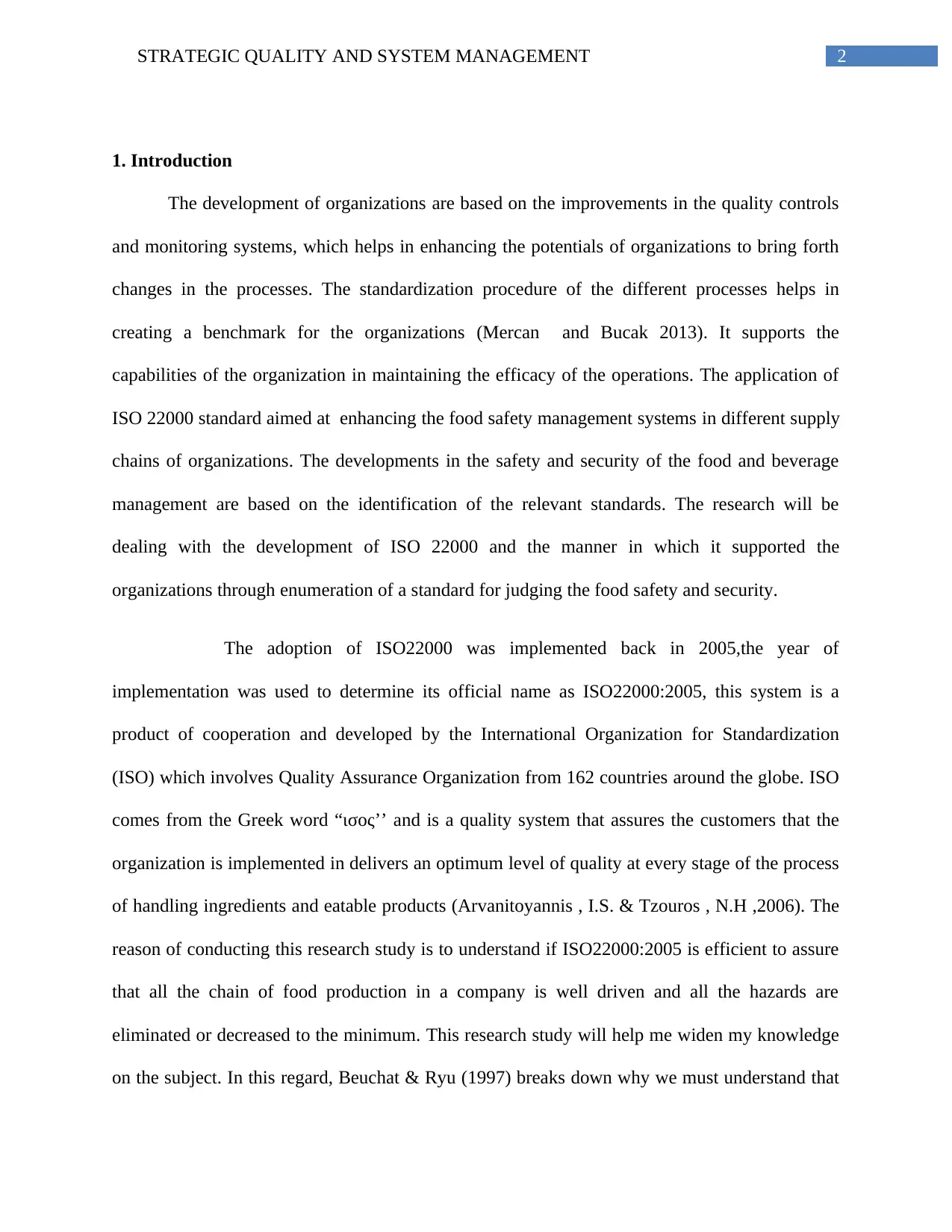
2STRATEGIC QUALITY AND SYSTEM MANAGEMENT
1. Introduction
The development of organizations are based on the improvements in the quality controls
and monitoring systems, which helps in enhancing the potentials of organizations to bring forth
changes in the processes. The standardization procedure of the different processes helps in
creating a benchmark for the organizations (Mercan and Bucak 2013). It supports the
capabilities of the organization in maintaining the efficacy of the operations. The application of
ISO 22000 standard aimed at enhancing the food safety management systems in different supply
chains of organizations. The developments in the safety and security of the food and beverage
management are based on the identification of the relevant standards. The research will be
dealing with the development of ISO 22000 and the manner in which it supported the
organizations through enumeration of a standard for judging the food safety and security.
The adoption of ISO22000 was implemented back in 2005,the year of
implementation was used to determine its official name as ISO22000:2005, this system is a
product of cooperation and developed by the International Organization for Standardization
(ISO) which involves Quality Assurance Organization from 162 countries around the globe. ISO
comes from the Greek word “ισος’’ and is a quality system that assures the customers that the
organization is implemented in delivers an optimum level of quality at every stage of the process
of handling ingredients and eatable products (Arvanitoyannis , I.S. & Tzouros , N.H ,2006). The
reason of conducting this research study is to understand if ISO22000:2005 is efficient to assure
that all the chain of food production in a company is well driven and all the hazards are
eliminated or decreased to the minimum. This research study will help me widen my knowledge
on the subject. In this regard, Beuchat & Ryu (1997) breaks down why we must understand that
1. Introduction
The development of organizations are based on the improvements in the quality controls
and monitoring systems, which helps in enhancing the potentials of organizations to bring forth
changes in the processes. The standardization procedure of the different processes helps in
creating a benchmark for the organizations (Mercan and Bucak 2013). It supports the
capabilities of the organization in maintaining the efficacy of the operations. The application of
ISO 22000 standard aimed at enhancing the food safety management systems in different supply
chains of organizations. The developments in the safety and security of the food and beverage
management are based on the identification of the relevant standards. The research will be
dealing with the development of ISO 22000 and the manner in which it supported the
organizations through enumeration of a standard for judging the food safety and security.
The adoption of ISO22000 was implemented back in 2005,the year of
implementation was used to determine its official name as ISO22000:2005, this system is a
product of cooperation and developed by the International Organization for Standardization
(ISO) which involves Quality Assurance Organization from 162 countries around the globe. ISO
comes from the Greek word “ισος’’ and is a quality system that assures the customers that the
organization is implemented in delivers an optimum level of quality at every stage of the process
of handling ingredients and eatable products (Arvanitoyannis , I.S. & Tzouros , N.H ,2006). The
reason of conducting this research study is to understand if ISO22000:2005 is efficient to assure
that all the chain of food production in a company is well driven and all the hazards are
eliminated or decreased to the minimum. This research study will help me widen my knowledge
on the subject. In this regard, Beuchat & Ryu (1997) breaks down why we must understand that
⊘ This is a preview!⊘
Do you want full access?
Subscribe today to unlock all pages.

Trusted by 1+ million students worldwide
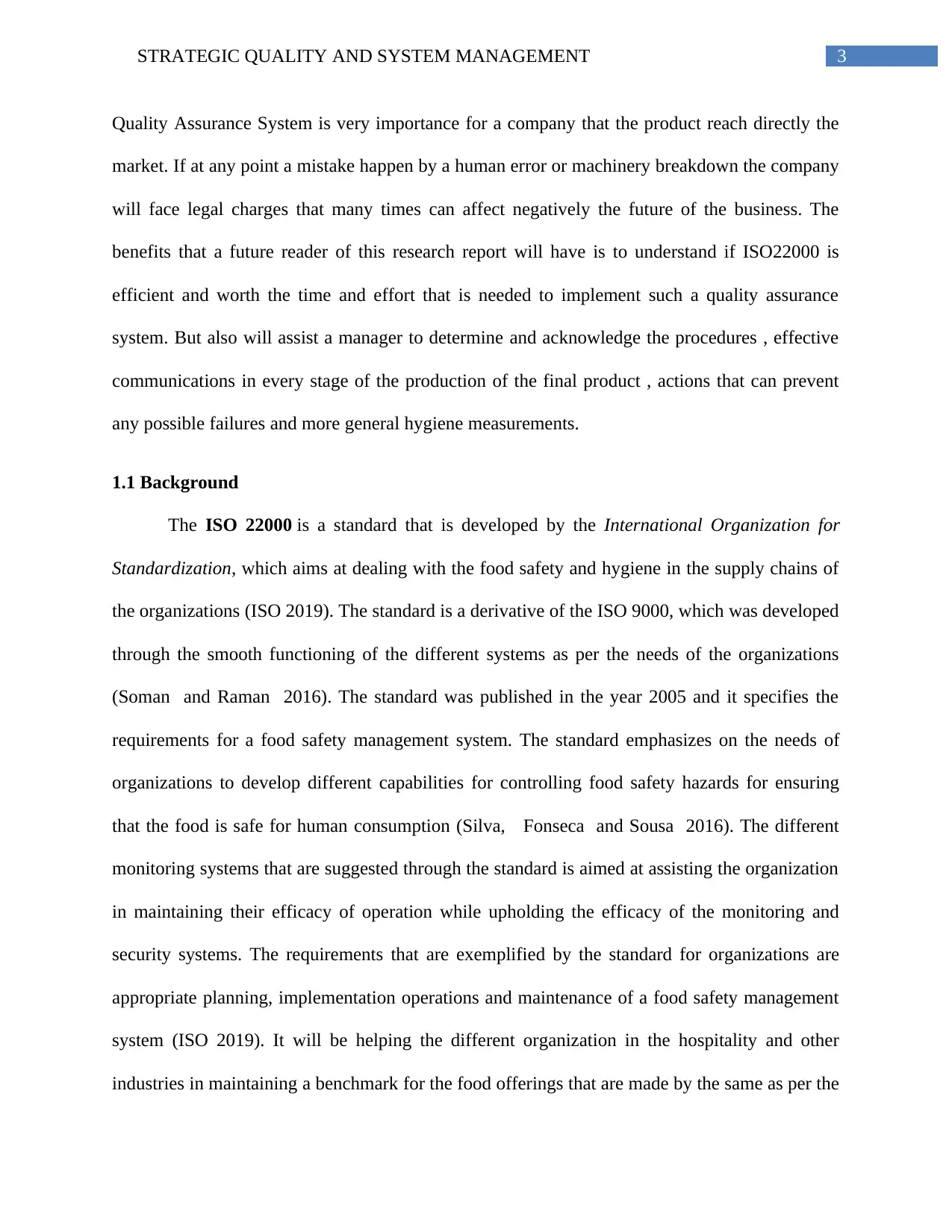
3STRATEGIC QUALITY AND SYSTEM MANAGEMENT
Quality Assurance System is very importance for a company that the product reach directly the
market. If at any point a mistake happen by a human error or machinery breakdown the company
will face legal charges that many times can affect negatively the future of the business. The
benefits that a future reader of this research report will have is to understand if ISO22000 is
efficient and worth the time and effort that is needed to implement such a quality assurance
system. But also will assist a manager to determine and acknowledge the procedures , effective
communications in every stage of the production of the final product , actions that can prevent
any possible failures and more general hygiene measurements.
1.1 Background
The ISO 22000 is a standard that is developed by the International Organization for
Standardization, which aims at dealing with the food safety and hygiene in the supply chains of
the organizations (ISO 2019). The standard is a derivative of the ISO 9000, which was developed
through the smooth functioning of the different systems as per the needs of the organizations
(Soman and Raman 2016). The standard was published in the year 2005 and it specifies the
requirements for a food safety management system. The standard emphasizes on the needs of
organizations to develop different capabilities for controlling food safety hazards for ensuring
that the food is safe for human consumption (Silva, Fonseca and Sousa 2016). The different
monitoring systems that are suggested through the standard is aimed at assisting the organization
in maintaining their efficacy of operation while upholding the efficacy of the monitoring and
security systems. The requirements that are exemplified by the standard for organizations are
appropriate planning, implementation operations and maintenance of a food safety management
system (ISO 2019). It will be helping the different organization in the hospitality and other
industries in maintaining a benchmark for the food offerings that are made by the same as per the
Quality Assurance System is very importance for a company that the product reach directly the
market. If at any point a mistake happen by a human error or machinery breakdown the company
will face legal charges that many times can affect negatively the future of the business. The
benefits that a future reader of this research report will have is to understand if ISO22000 is
efficient and worth the time and effort that is needed to implement such a quality assurance
system. But also will assist a manager to determine and acknowledge the procedures , effective
communications in every stage of the production of the final product , actions that can prevent
any possible failures and more general hygiene measurements.
1.1 Background
The ISO 22000 is a standard that is developed by the International Organization for
Standardization, which aims at dealing with the food safety and hygiene in the supply chains of
the organizations (ISO 2019). The standard is a derivative of the ISO 9000, which was developed
through the smooth functioning of the different systems as per the needs of the organizations
(Soman and Raman 2016). The standard was published in the year 2005 and it specifies the
requirements for a food safety management system. The standard emphasizes on the needs of
organizations to develop different capabilities for controlling food safety hazards for ensuring
that the food is safe for human consumption (Silva, Fonseca and Sousa 2016). The different
monitoring systems that are suggested through the standard is aimed at assisting the organization
in maintaining their efficacy of operation while upholding the efficacy of the monitoring and
security systems. The requirements that are exemplified by the standard for organizations are
appropriate planning, implementation operations and maintenance of a food safety management
system (ISO 2019). It will be helping the different organization in the hospitality and other
industries in maintaining a benchmark for the food offerings that are made by the same as per the
Paraphrase This Document
Need a fresh take? Get an instant paraphrase of this document with our AI Paraphraser
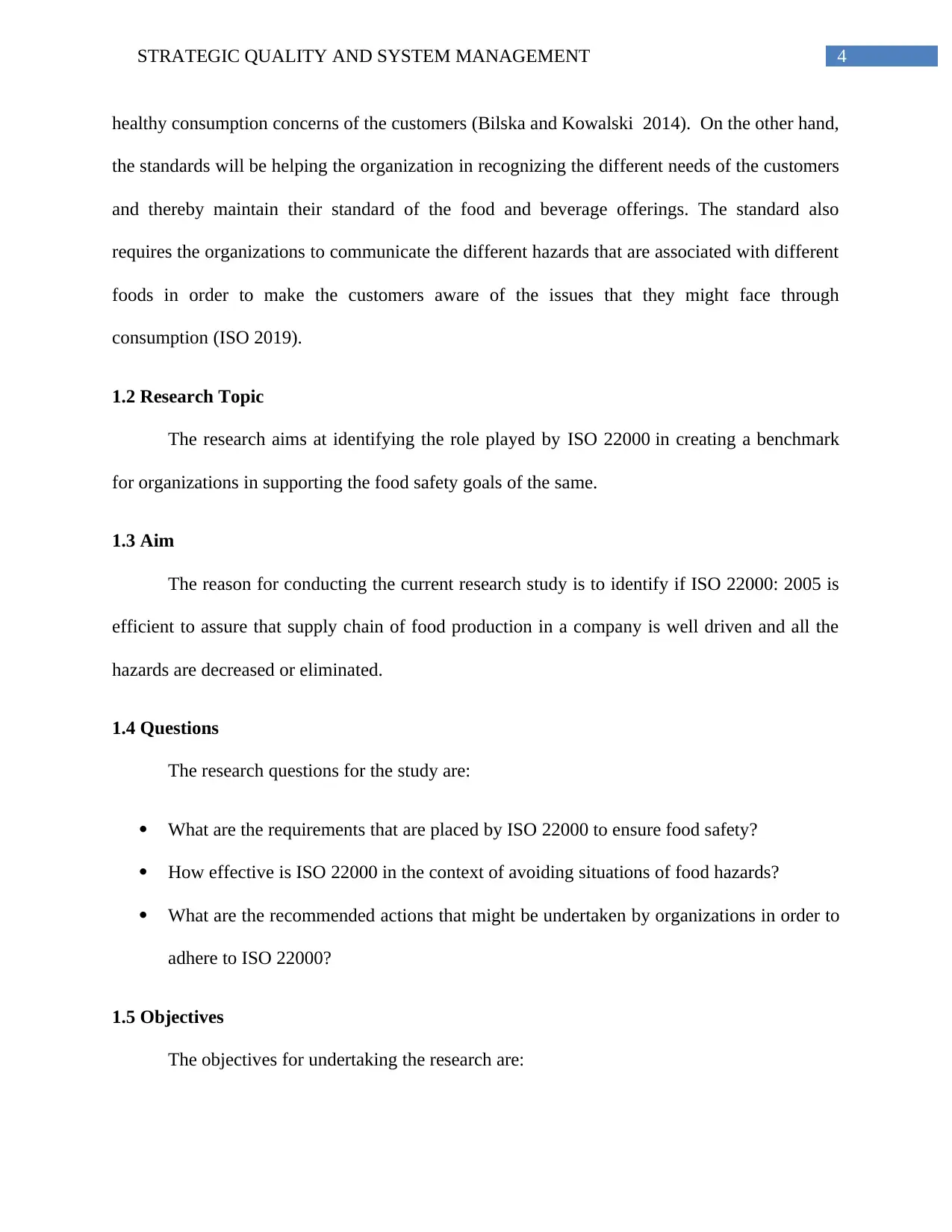
4STRATEGIC QUALITY AND SYSTEM MANAGEMENT
healthy consumption concerns of the customers (Bilska and Kowalski 2014). On the other hand,
the standards will be helping the organization in recognizing the different needs of the customers
and thereby maintain their standard of the food and beverage offerings. The standard also
requires the organizations to communicate the different hazards that are associated with different
foods in order to make the customers aware of the issues that they might face through
consumption (ISO 2019).
1.2 Research Topic
The research aims at identifying the role played by ISO 22000 in creating a benchmark
for organizations in supporting the food safety goals of the same.
1.3 Aim
The reason for conducting the current research study is to identify if ISO 22000: 2005 is
efficient to assure that supply chain of food production in a company is well driven and all the
hazards are decreased or eliminated.
1.4 Questions
The research questions for the study are:
What are the requirements that are placed by ISO 22000 to ensure food safety?
How effective is ISO 22000 in the context of avoiding situations of food hazards?
What are the recommended actions that might be undertaken by organizations in order to
adhere to ISO 22000?
1.5 Objectives
The objectives for undertaking the research are:
healthy consumption concerns of the customers (Bilska and Kowalski 2014). On the other hand,
the standards will be helping the organization in recognizing the different needs of the customers
and thereby maintain their standard of the food and beverage offerings. The standard also
requires the organizations to communicate the different hazards that are associated with different
foods in order to make the customers aware of the issues that they might face through
consumption (ISO 2019).
1.2 Research Topic
The research aims at identifying the role played by ISO 22000 in creating a benchmark
for organizations in supporting the food safety goals of the same.
1.3 Aim
The reason for conducting the current research study is to identify if ISO 22000: 2005 is
efficient to assure that supply chain of food production in a company is well driven and all the
hazards are decreased or eliminated.
1.4 Questions
The research questions for the study are:
What are the requirements that are placed by ISO 22000 to ensure food safety?
How effective is ISO 22000 in the context of avoiding situations of food hazards?
What are the recommended actions that might be undertaken by organizations in order to
adhere to ISO 22000?
1.5 Objectives
The objectives for undertaking the research are:
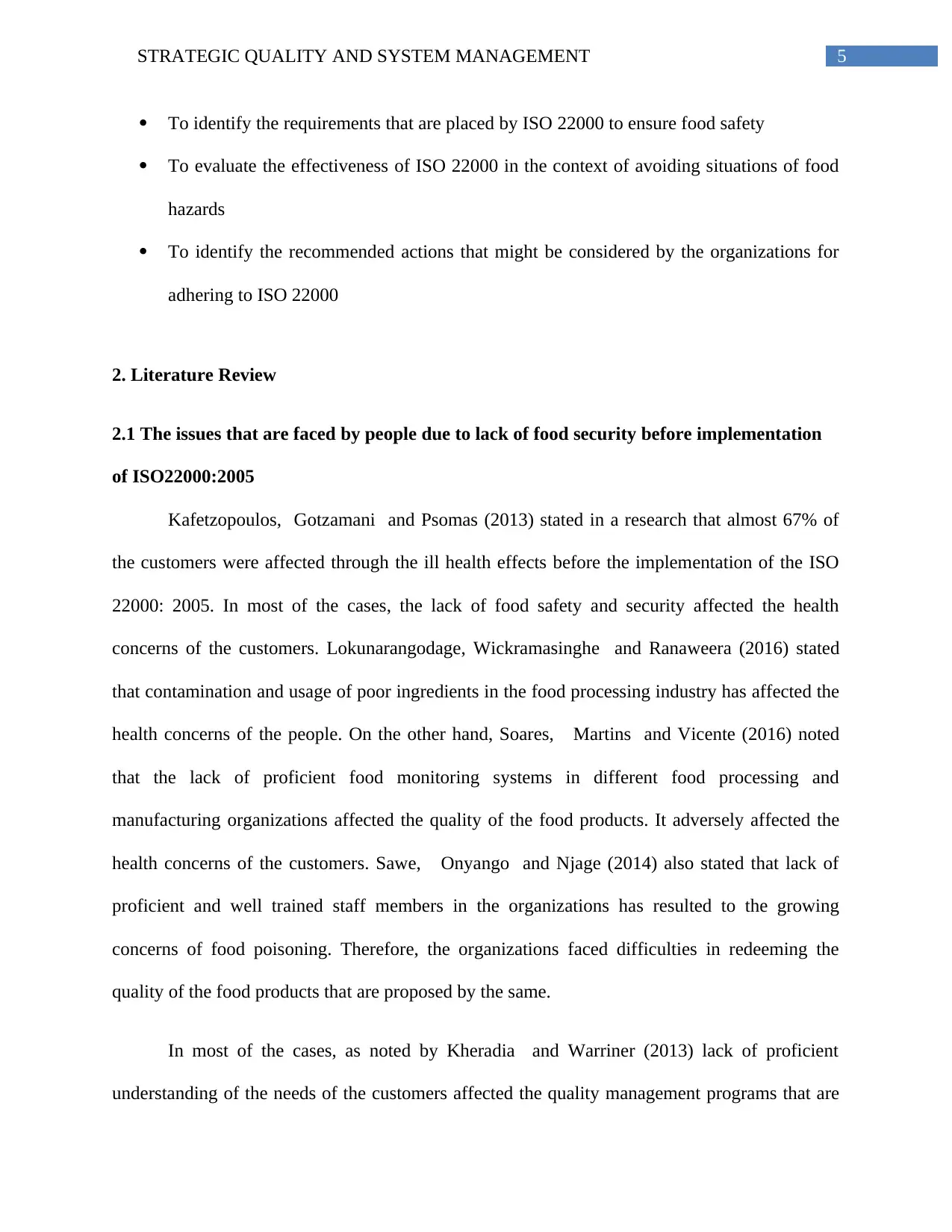
5STRATEGIC QUALITY AND SYSTEM MANAGEMENT
To identify the requirements that are placed by ISO 22000 to ensure food safety
To evaluate the effectiveness of ISO 22000 in the context of avoiding situations of food
hazards
To identify the recommended actions that might be considered by the organizations for
adhering to ISO 22000
2. Literature Review
2.1 The issues that are faced by people due to lack of food security before implementation
of ISO22000:2005
Kafetzopoulos, Gotzamani and Psomas (2013) stated in a research that almost 67% of
the customers were affected through the ill health effects before the implementation of the ISO
22000: 2005. In most of the cases, the lack of food safety and security affected the health
concerns of the customers. Lokunarangodage, Wickramasinghe and Ranaweera (2016) stated
that contamination and usage of poor ingredients in the food processing industry has affected the
health concerns of the people. On the other hand, Soares, Martins and Vicente (2016) noted
that the lack of proficient food monitoring systems in different food processing and
manufacturing organizations affected the quality of the food products. It adversely affected the
health concerns of the customers. Sawe, Onyango and Njage (2014) also stated that lack of
proficient and well trained staff members in the organizations has resulted to the growing
concerns of food poisoning. Therefore, the organizations faced difficulties in redeeming the
quality of the food products that are proposed by the same.
In most of the cases, as noted by Kheradia and Warriner (2013) lack of proficient
understanding of the needs of the customers affected the quality management programs that are
To identify the requirements that are placed by ISO 22000 to ensure food safety
To evaluate the effectiveness of ISO 22000 in the context of avoiding situations of food
hazards
To identify the recommended actions that might be considered by the organizations for
adhering to ISO 22000
2. Literature Review
2.1 The issues that are faced by people due to lack of food security before implementation
of ISO22000:2005
Kafetzopoulos, Gotzamani and Psomas (2013) stated in a research that almost 67% of
the customers were affected through the ill health effects before the implementation of the ISO
22000: 2005. In most of the cases, the lack of food safety and security affected the health
concerns of the customers. Lokunarangodage, Wickramasinghe and Ranaweera (2016) stated
that contamination and usage of poor ingredients in the food processing industry has affected the
health concerns of the people. On the other hand, Soares, Martins and Vicente (2016) noted
that the lack of proficient food monitoring systems in different food processing and
manufacturing organizations affected the quality of the food products. It adversely affected the
health concerns of the customers. Sawe, Onyango and Njage (2014) also stated that lack of
proficient and well trained staff members in the organizations has resulted to the growing
concerns of food poisoning. Therefore, the organizations faced difficulties in redeeming the
quality of the food products that are proposed by the same.
In most of the cases, as noted by Kheradia and Warriner (2013) lack of proficient
understanding of the needs of the customers affected the quality management programs that are
⊘ This is a preview!⊘
Do you want full access?
Subscribe today to unlock all pages.

Trusted by 1+ million students worldwide
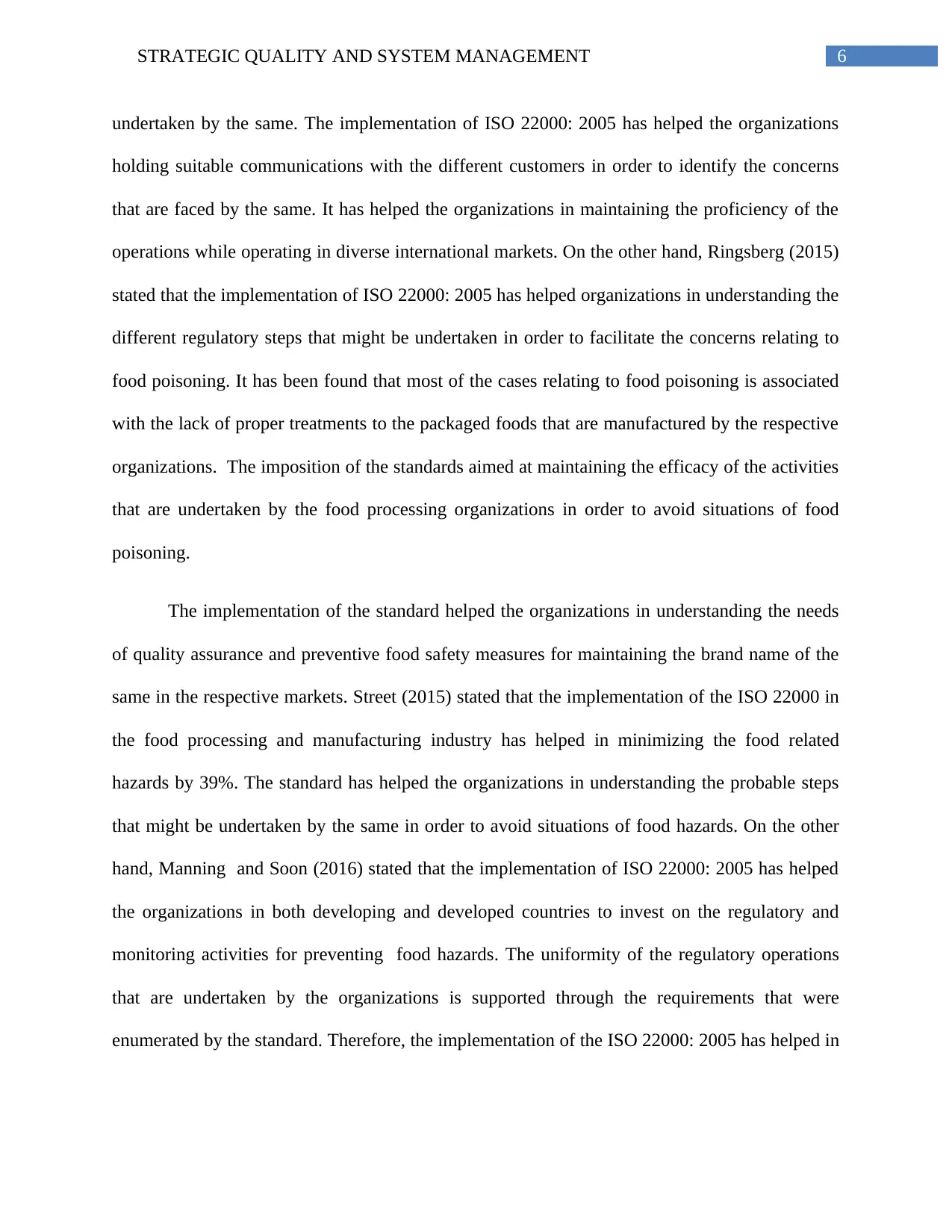
6STRATEGIC QUALITY AND SYSTEM MANAGEMENT
undertaken by the same. The implementation of ISO 22000: 2005 has helped the organizations
holding suitable communications with the different customers in order to identify the concerns
that are faced by the same. It has helped the organizations in maintaining the proficiency of the
operations while operating in diverse international markets. On the other hand, Ringsberg (2015)
stated that the implementation of ISO 22000: 2005 has helped organizations in understanding the
different regulatory steps that might be undertaken in order to facilitate the concerns relating to
food poisoning. It has been found that most of the cases relating to food poisoning is associated
with the lack of proper treatments to the packaged foods that are manufactured by the respective
organizations. The imposition of the standards aimed at maintaining the efficacy of the activities
that are undertaken by the food processing organizations in order to avoid situations of food
poisoning.
The implementation of the standard helped the organizations in understanding the needs
of quality assurance and preventive food safety measures for maintaining the brand name of the
same in the respective markets. Street (2015) stated that the implementation of the ISO 22000 in
the food processing and manufacturing industry has helped in minimizing the food related
hazards by 39%. The standard has helped the organizations in understanding the probable steps
that might be undertaken by the same in order to avoid situations of food hazards. On the other
hand, Manning and Soon (2016) stated that the implementation of ISO 22000: 2005 has helped
the organizations in both developing and developed countries to invest on the regulatory and
monitoring activities for preventing food hazards. The uniformity of the regulatory operations
that are undertaken by the organizations is supported through the requirements that were
enumerated by the standard. Therefore, the implementation of the ISO 22000: 2005 has helped in
undertaken by the same. The implementation of ISO 22000: 2005 has helped the organizations
holding suitable communications with the different customers in order to identify the concerns
that are faced by the same. It has helped the organizations in maintaining the proficiency of the
operations while operating in diverse international markets. On the other hand, Ringsberg (2015)
stated that the implementation of ISO 22000: 2005 has helped organizations in understanding the
different regulatory steps that might be undertaken in order to facilitate the concerns relating to
food poisoning. It has been found that most of the cases relating to food poisoning is associated
with the lack of proper treatments to the packaged foods that are manufactured by the respective
organizations. The imposition of the standards aimed at maintaining the efficacy of the activities
that are undertaken by the food processing organizations in order to avoid situations of food
poisoning.
The implementation of the standard helped the organizations in understanding the needs
of quality assurance and preventive food safety measures for maintaining the brand name of the
same in the respective markets. Street (2015) stated that the implementation of the ISO 22000 in
the food processing and manufacturing industry has helped in minimizing the food related
hazards by 39%. The standard has helped the organizations in understanding the probable steps
that might be undertaken by the same in order to avoid situations of food hazards. On the other
hand, Manning and Soon (2016) stated that the implementation of ISO 22000: 2005 has helped
the organizations in both developing and developed countries to invest on the regulatory and
monitoring activities for preventing food hazards. The uniformity of the regulatory operations
that are undertaken by the organizations is supported through the requirements that were
enumerated by the standard. Therefore, the implementation of the ISO 22000: 2005 has helped in
Paraphrase This Document
Need a fresh take? Get an instant paraphrase of this document with our AI Paraphraser
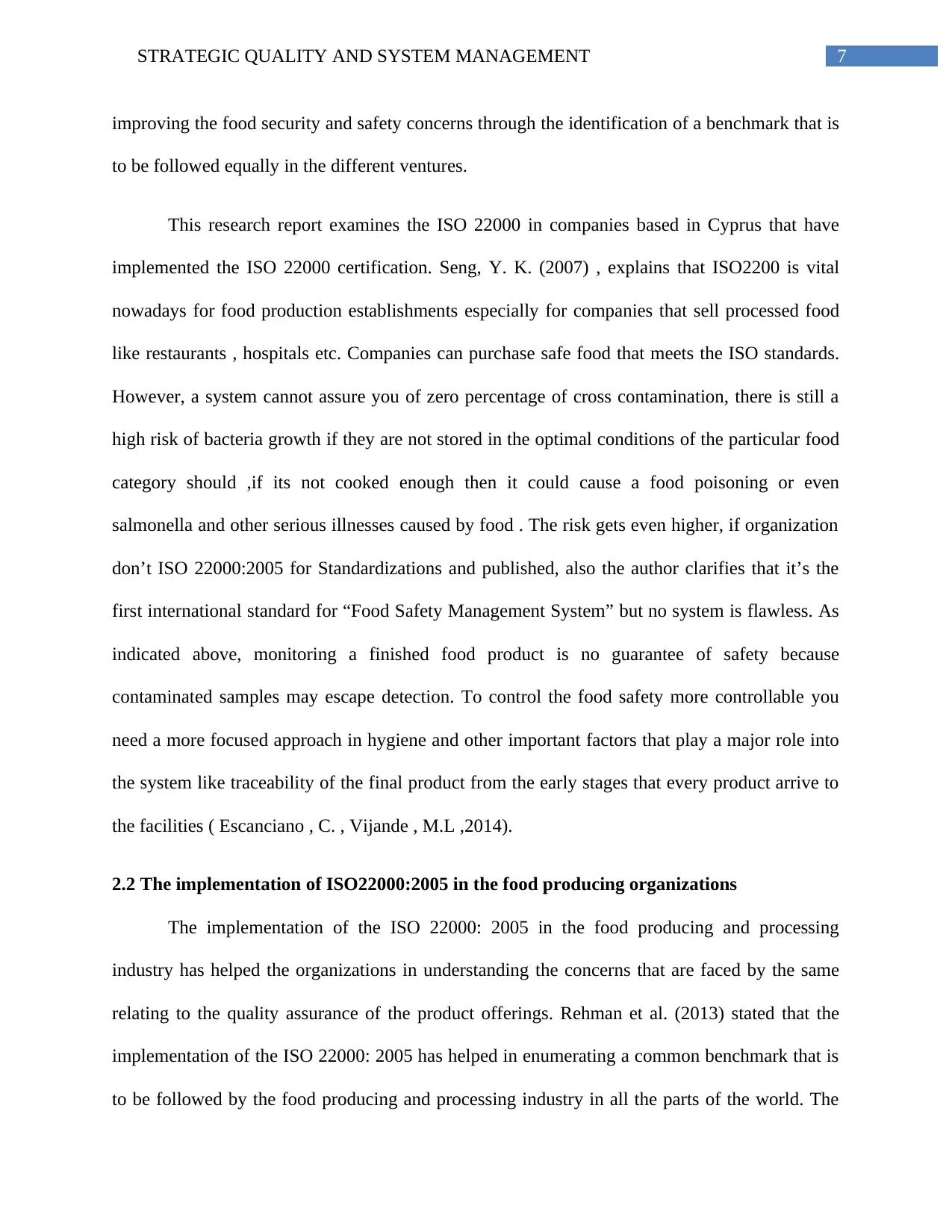
7STRATEGIC QUALITY AND SYSTEM MANAGEMENT
improving the food security and safety concerns through the identification of a benchmark that is
to be followed equally in the different ventures.
This research report examines the ISO 22000 in companies based in Cyprus that have
implemented the ISO 22000 certification. Seng, Y. K. (2007) , explains that ISO2200 is vital
nowadays for food production establishments especially for companies that sell processed food
like restaurants , hospitals etc. Companies can purchase safe food that meets the ISO standards.
However, a system cannot assure you of zero percentage of cross contamination, there is still a
high risk of bacteria growth if they are not stored in the optimal conditions of the particular food
category should ,if its not cooked enough then it could cause a food poisoning or even
salmonella and other serious illnesses caused by food . The risk gets even higher, if organization
don’t ISO 22000:2005 for Standardizations and published, also the author clarifies that it’s the
first international standard for “Food Safety Management System” but no system is flawless. As
indicated above, monitoring a finished food product is no guarantee of safety because
contaminated samples may escape detection. To control the food safety more controllable you
need a more focused approach in hygiene and other important factors that play a major role into
the system like traceability of the final product from the early stages that every product arrive to
the facilities ( Escanciano , C. , Vijande , M.L ,2014).
2.2 The implementation of ISO22000:2005 in the food producing organizations
The implementation of the ISO 22000: 2005 in the food producing and processing
industry has helped the organizations in understanding the concerns that are faced by the same
relating to the quality assurance of the product offerings. Rehman et al. (2013) stated that the
implementation of the ISO 22000: 2005 has helped in enumerating a common benchmark that is
to be followed by the food producing and processing industry in all the parts of the world. The
improving the food security and safety concerns through the identification of a benchmark that is
to be followed equally in the different ventures.
This research report examines the ISO 22000 in companies based in Cyprus that have
implemented the ISO 22000 certification. Seng, Y. K. (2007) , explains that ISO2200 is vital
nowadays for food production establishments especially for companies that sell processed food
like restaurants , hospitals etc. Companies can purchase safe food that meets the ISO standards.
However, a system cannot assure you of zero percentage of cross contamination, there is still a
high risk of bacteria growth if they are not stored in the optimal conditions of the particular food
category should ,if its not cooked enough then it could cause a food poisoning or even
salmonella and other serious illnesses caused by food . The risk gets even higher, if organization
don’t ISO 22000:2005 for Standardizations and published, also the author clarifies that it’s the
first international standard for “Food Safety Management System” but no system is flawless. As
indicated above, monitoring a finished food product is no guarantee of safety because
contaminated samples may escape detection. To control the food safety more controllable you
need a more focused approach in hygiene and other important factors that play a major role into
the system like traceability of the final product from the early stages that every product arrive to
the facilities ( Escanciano , C. , Vijande , M.L ,2014).
2.2 The implementation of ISO22000:2005 in the food producing organizations
The implementation of the ISO 22000: 2005 in the food producing and processing
industry has helped the organizations in understanding the concerns that are faced by the same
relating to the quality assurance of the product offerings. Rehman et al. (2013) stated that the
implementation of the ISO 22000: 2005 has helped in enumerating a common benchmark that is
to be followed by the food producing and processing industry in all the parts of the world. The
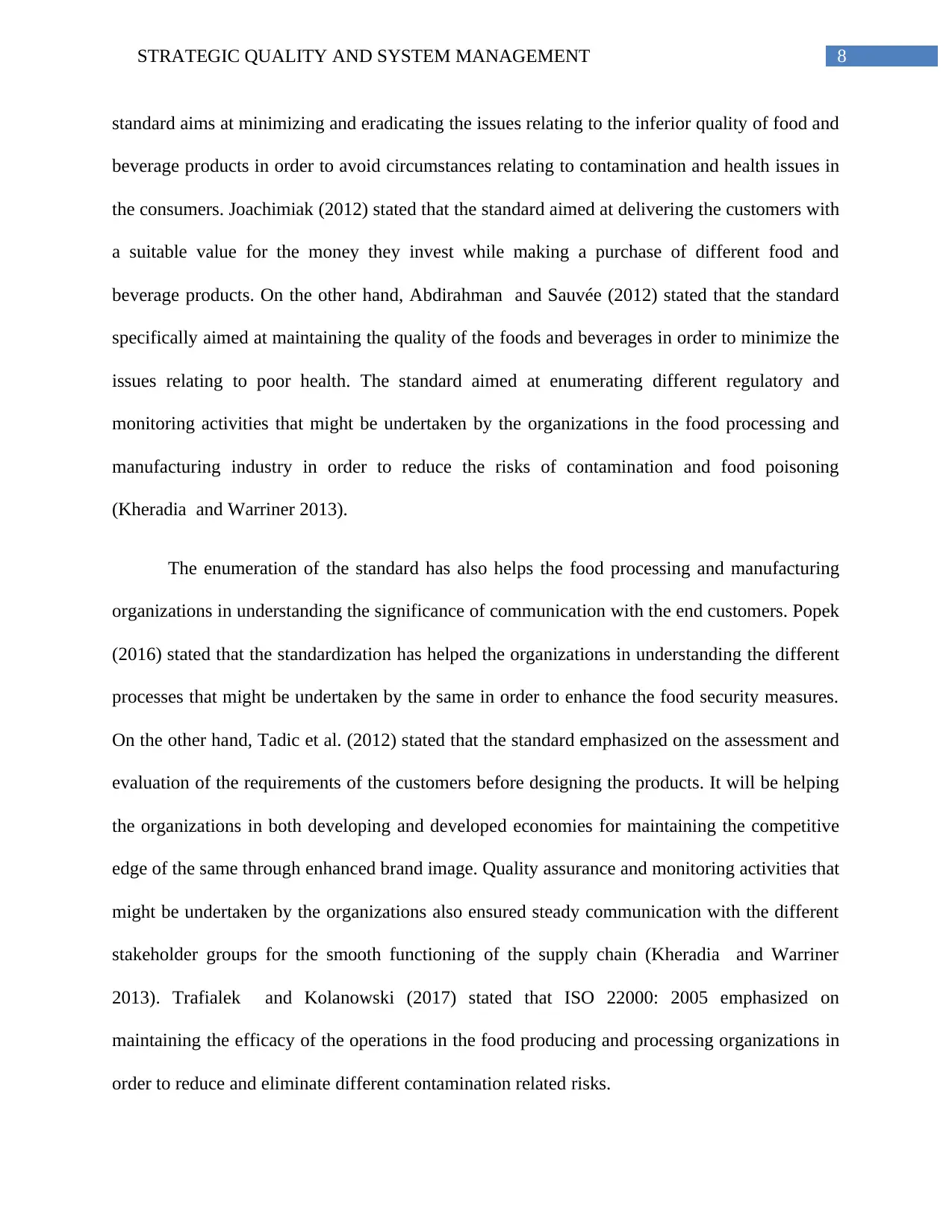
8STRATEGIC QUALITY AND SYSTEM MANAGEMENT
standard aims at minimizing and eradicating the issues relating to the inferior quality of food and
beverage products in order to avoid circumstances relating to contamination and health issues in
the consumers. Joachimiak (2012) stated that the standard aimed at delivering the customers with
a suitable value for the money they invest while making a purchase of different food and
beverage products. On the other hand, Abdirahman and Sauvée (2012) stated that the standard
specifically aimed at maintaining the quality of the foods and beverages in order to minimize the
issues relating to poor health. The standard aimed at enumerating different regulatory and
monitoring activities that might be undertaken by the organizations in the food processing and
manufacturing industry in order to reduce the risks of contamination and food poisoning
(Kheradia and Warriner 2013).
The enumeration of the standard has also helps the food processing and manufacturing
organizations in understanding the significance of communication with the end customers. Popek
(2016) stated that the standardization has helped the organizations in understanding the different
processes that might be undertaken by the same in order to enhance the food security measures.
On the other hand, Tadic et al. (2012) stated that the standard emphasized on the assessment and
evaluation of the requirements of the customers before designing the products. It will be helping
the organizations in both developing and developed economies for maintaining the competitive
edge of the same through enhanced brand image. Quality assurance and monitoring activities that
might be undertaken by the organizations also ensured steady communication with the different
stakeholder groups for the smooth functioning of the supply chain (Kheradia and Warriner
2013). Trafialek and Kolanowski (2017) stated that ISO 22000: 2005 emphasized on
maintaining the efficacy of the operations in the food producing and processing organizations in
order to reduce and eliminate different contamination related risks.
standard aims at minimizing and eradicating the issues relating to the inferior quality of food and
beverage products in order to avoid circumstances relating to contamination and health issues in
the consumers. Joachimiak (2012) stated that the standard aimed at delivering the customers with
a suitable value for the money they invest while making a purchase of different food and
beverage products. On the other hand, Abdirahman and Sauvée (2012) stated that the standard
specifically aimed at maintaining the quality of the foods and beverages in order to minimize the
issues relating to poor health. The standard aimed at enumerating different regulatory and
monitoring activities that might be undertaken by the organizations in the food processing and
manufacturing industry in order to reduce the risks of contamination and food poisoning
(Kheradia and Warriner 2013).
The enumeration of the standard has also helps the food processing and manufacturing
organizations in understanding the significance of communication with the end customers. Popek
(2016) stated that the standardization has helped the organizations in understanding the different
processes that might be undertaken by the same in order to enhance the food security measures.
On the other hand, Tadic et al. (2012) stated that the standard emphasized on the assessment and
evaluation of the requirements of the customers before designing the products. It will be helping
the organizations in both developing and developed economies for maintaining the competitive
edge of the same through enhanced brand image. Quality assurance and monitoring activities that
might be undertaken by the organizations also ensured steady communication with the different
stakeholder groups for the smooth functioning of the supply chain (Kheradia and Warriner
2013). Trafialek and Kolanowski (2017) stated that ISO 22000: 2005 emphasized on
maintaining the efficacy of the operations in the food producing and processing organizations in
order to reduce and eliminate different contamination related risks.
⊘ This is a preview!⊘
Do you want full access?
Subscribe today to unlock all pages.

Trusted by 1+ million students worldwide
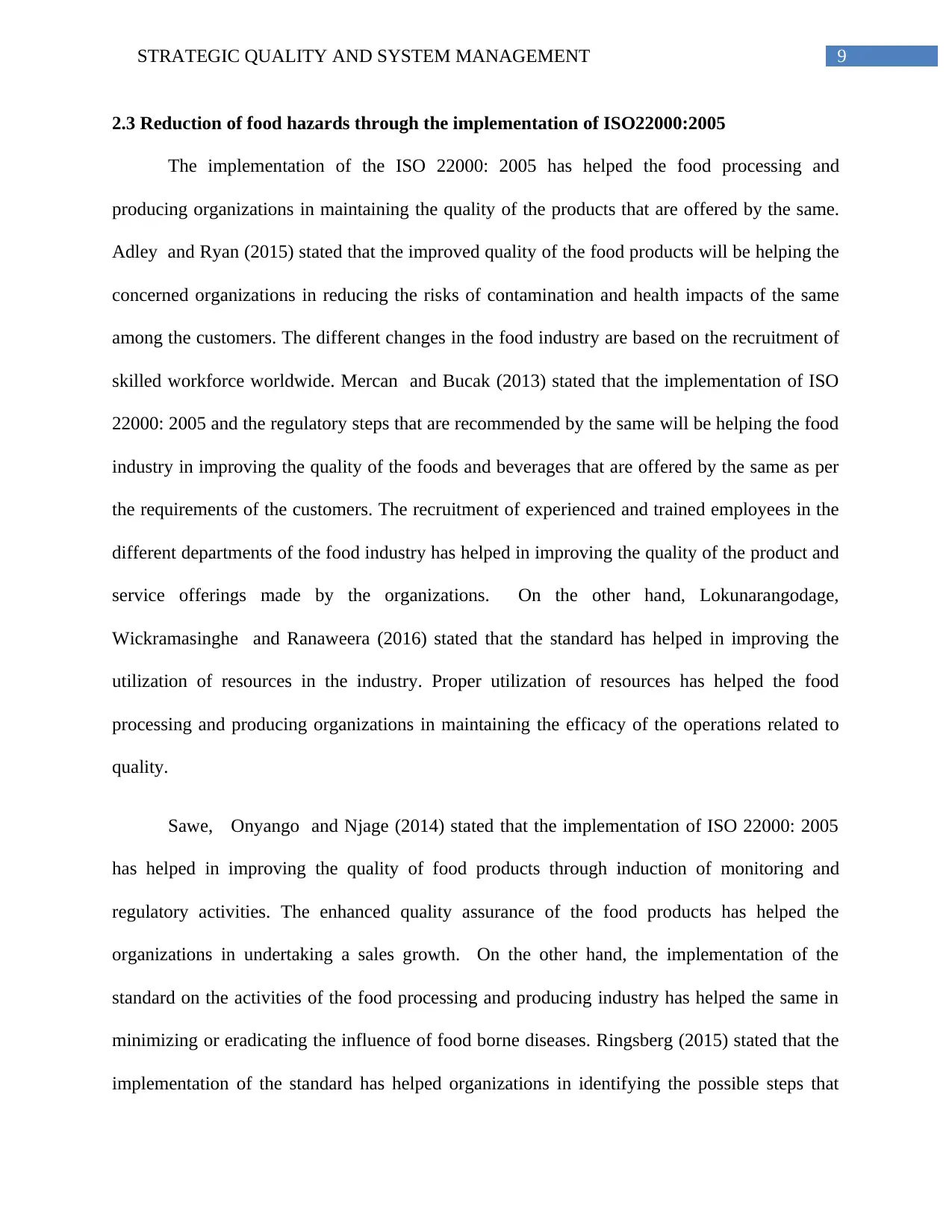
9STRATEGIC QUALITY AND SYSTEM MANAGEMENT
2.3 Reduction of food hazards through the implementation of ISO22000:2005
The implementation of the ISO 22000: 2005 has helped the food processing and
producing organizations in maintaining the quality of the products that are offered by the same.
Adley and Ryan (2015) stated that the improved quality of the food products will be helping the
concerned organizations in reducing the risks of contamination and health impacts of the same
among the customers. The different changes in the food industry are based on the recruitment of
skilled workforce worldwide. Mercan and Bucak (2013) stated that the implementation of ISO
22000: 2005 and the regulatory steps that are recommended by the same will be helping the food
industry in improving the quality of the foods and beverages that are offered by the same as per
the requirements of the customers. The recruitment of experienced and trained employees in the
different departments of the food industry has helped in improving the quality of the product and
service offerings made by the organizations. On the other hand, Lokunarangodage,
Wickramasinghe and Ranaweera (2016) stated that the standard has helped in improving the
utilization of resources in the industry. Proper utilization of resources has helped the food
processing and producing organizations in maintaining the efficacy of the operations related to
quality.
Sawe, Onyango and Njage (2014) stated that the implementation of ISO 22000: 2005
has helped in improving the quality of food products through induction of monitoring and
regulatory activities. The enhanced quality assurance of the food products has helped the
organizations in undertaking a sales growth. On the other hand, the implementation of the
standard on the activities of the food processing and producing industry has helped the same in
minimizing or eradicating the influence of food borne diseases. Ringsberg (2015) stated that the
implementation of the standard has helped organizations in identifying the possible steps that
2.3 Reduction of food hazards through the implementation of ISO22000:2005
The implementation of the ISO 22000: 2005 has helped the food processing and
producing organizations in maintaining the quality of the products that are offered by the same.
Adley and Ryan (2015) stated that the improved quality of the food products will be helping the
concerned organizations in reducing the risks of contamination and health impacts of the same
among the customers. The different changes in the food industry are based on the recruitment of
skilled workforce worldwide. Mercan and Bucak (2013) stated that the implementation of ISO
22000: 2005 and the regulatory steps that are recommended by the same will be helping the food
industry in improving the quality of the foods and beverages that are offered by the same as per
the requirements of the customers. The recruitment of experienced and trained employees in the
different departments of the food industry has helped in improving the quality of the product and
service offerings made by the organizations. On the other hand, Lokunarangodage,
Wickramasinghe and Ranaweera (2016) stated that the standard has helped in improving the
utilization of resources in the industry. Proper utilization of resources has helped the food
processing and producing organizations in maintaining the efficacy of the operations related to
quality.
Sawe, Onyango and Njage (2014) stated that the implementation of ISO 22000: 2005
has helped in improving the quality of food products through induction of monitoring and
regulatory activities. The enhanced quality assurance of the food products has helped the
organizations in undertaking a sales growth. On the other hand, the implementation of the
standard on the activities of the food processing and producing industry has helped the same in
minimizing or eradicating the influence of food borne diseases. Ringsberg (2015) stated that the
implementation of the standard has helped organizations in identifying the possible steps that
Paraphrase This Document
Need a fresh take? Get an instant paraphrase of this document with our AI Paraphraser
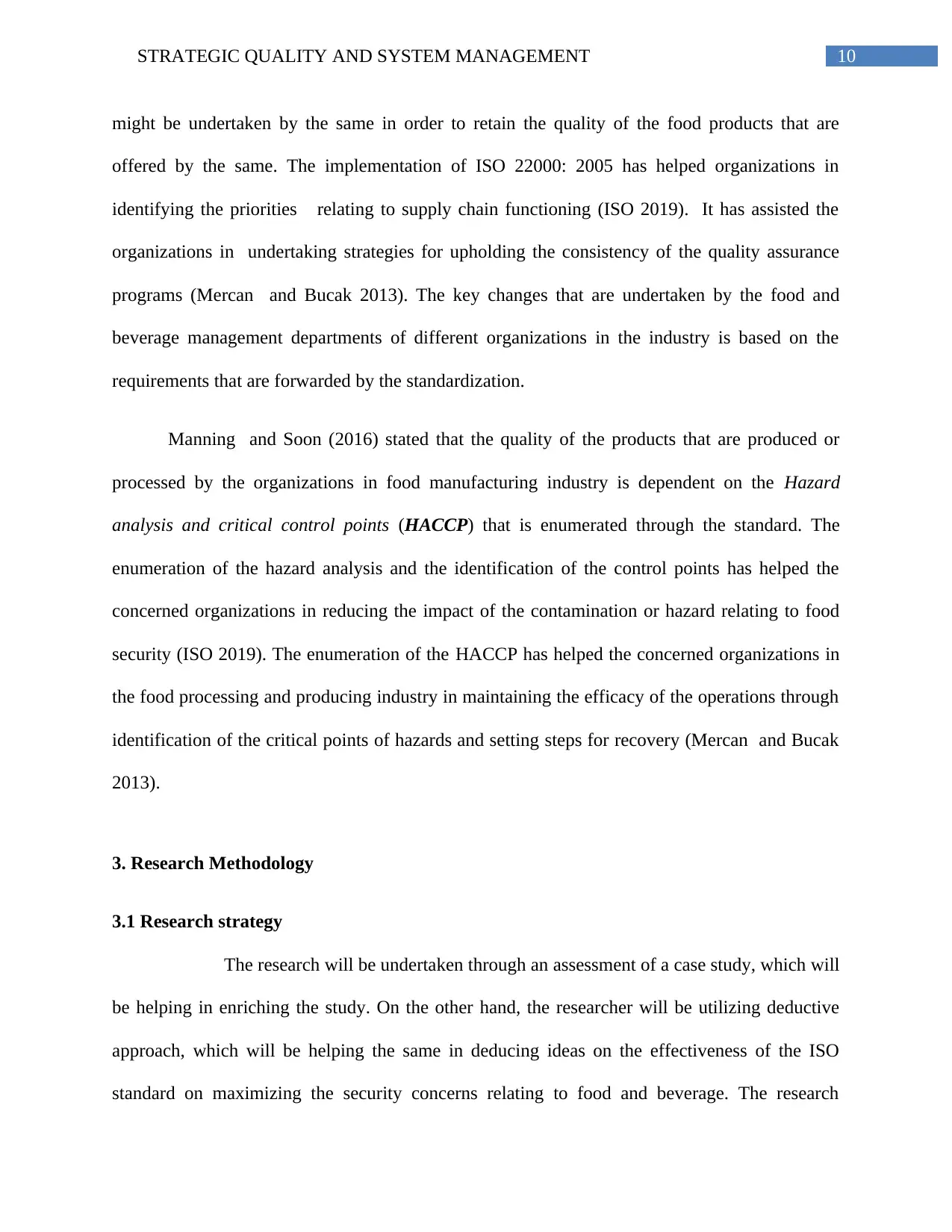
10STRATEGIC QUALITY AND SYSTEM MANAGEMENT
might be undertaken by the same in order to retain the quality of the food products that are
offered by the same. The implementation of ISO 22000: 2005 has helped organizations in
identifying the priorities relating to supply chain functioning (ISO 2019). It has assisted the
organizations in undertaking strategies for upholding the consistency of the quality assurance
programs (Mercan and Bucak 2013). The key changes that are undertaken by the food and
beverage management departments of different organizations in the industry is based on the
requirements that are forwarded by the standardization.
Manning and Soon (2016) stated that the quality of the products that are produced or
processed by the organizations in food manufacturing industry is dependent on the Hazard
analysis and critical control points (HACCP) that is enumerated through the standard. The
enumeration of the hazard analysis and the identification of the control points has helped the
concerned organizations in reducing the impact of the contamination or hazard relating to food
security (ISO 2019). The enumeration of the HACCP has helped the concerned organizations in
the food processing and producing industry in maintaining the efficacy of the operations through
identification of the critical points of hazards and setting steps for recovery (Mercan and Bucak
2013).
3. Research Methodology
3.1 Research strategy
The research will be undertaken through an assessment of a case study, which will
be helping in enriching the study. On the other hand, the researcher will be utilizing deductive
approach, which will be helping the same in deducing ideas on the effectiveness of the ISO
standard on maximizing the security concerns relating to food and beverage. The research
might be undertaken by the same in order to retain the quality of the food products that are
offered by the same. The implementation of ISO 22000: 2005 has helped organizations in
identifying the priorities relating to supply chain functioning (ISO 2019). It has assisted the
organizations in undertaking strategies for upholding the consistency of the quality assurance
programs (Mercan and Bucak 2013). The key changes that are undertaken by the food and
beverage management departments of different organizations in the industry is based on the
requirements that are forwarded by the standardization.
Manning and Soon (2016) stated that the quality of the products that are produced or
processed by the organizations in food manufacturing industry is dependent on the Hazard
analysis and critical control points (HACCP) that is enumerated through the standard. The
enumeration of the hazard analysis and the identification of the control points has helped the
concerned organizations in reducing the impact of the contamination or hazard relating to food
security (ISO 2019). The enumeration of the HACCP has helped the concerned organizations in
the food processing and producing industry in maintaining the efficacy of the operations through
identification of the critical points of hazards and setting steps for recovery (Mercan and Bucak
2013).
3. Research Methodology
3.1 Research strategy
The research will be undertaken through an assessment of a case study, which will
be helping in enriching the study. On the other hand, the researcher will be utilizing deductive
approach, which will be helping the same in deducing ideas on the effectiveness of the ISO
standard on maximizing the security concerns relating to food and beverage. The research
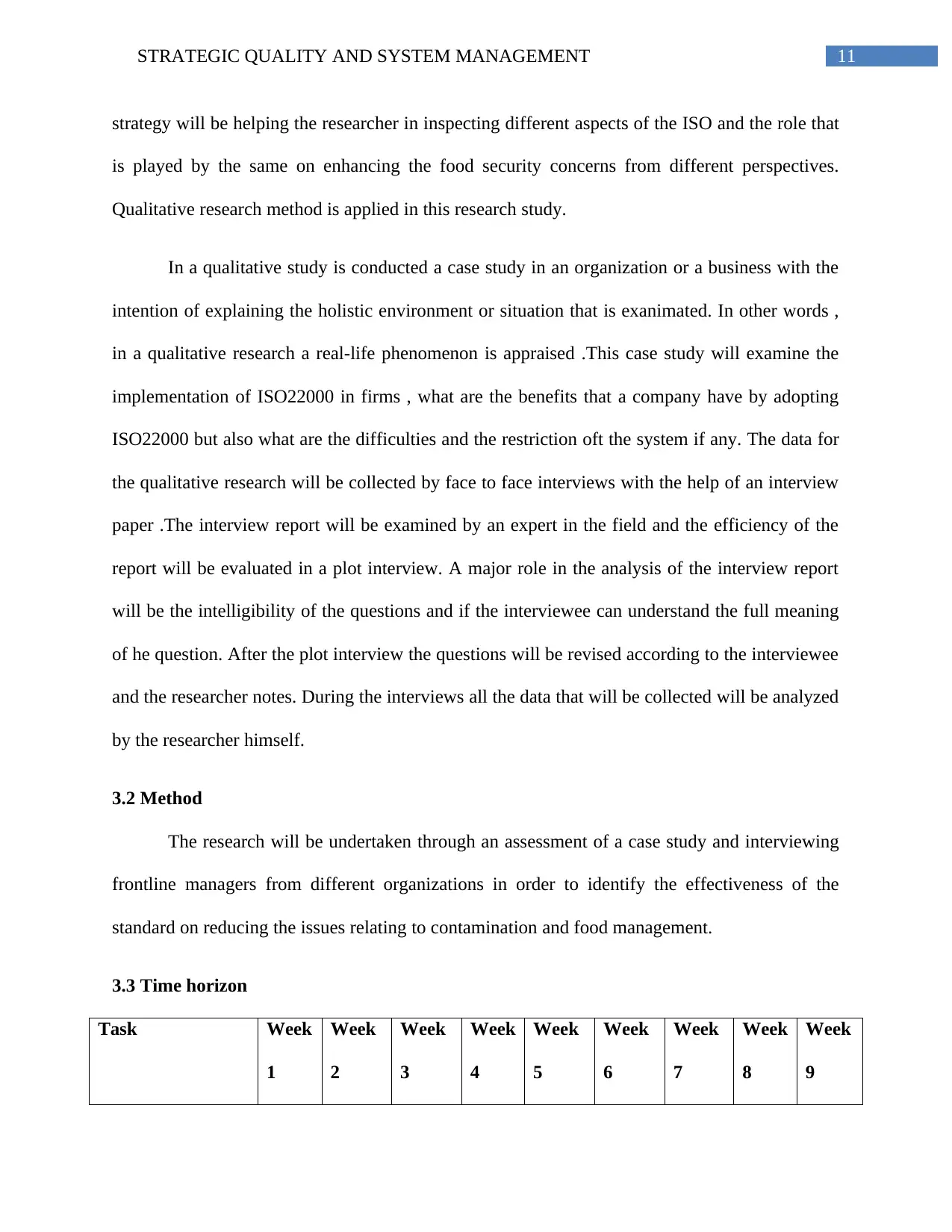
11STRATEGIC QUALITY AND SYSTEM MANAGEMENT
strategy will be helping the researcher in inspecting different aspects of the ISO and the role that
is played by the same on enhancing the food security concerns from different perspectives.
Qualitative research method is applied in this research study.
In a qualitative study is conducted a case study in an organization or a business with the
intention of explaining the holistic environment or situation that is exanimated. In other words ,
in a qualitative research a real-life phenomenon is appraised .This case study will examine the
implementation of ISO22000 in firms , what are the benefits that a company have by adopting
ISO22000 but also what are the difficulties and the restriction oft the system if any. The data for
the qualitative research will be collected by face to face interviews with the help of an interview
paper .The interview report will be examined by an expert in the field and the efficiency of the
report will be evaluated in a plot interview. A major role in the analysis of the interview report
will be the intelligibility of the questions and if the interviewee can understand the full meaning
of he question. After the plot interview the questions will be revised according to the interviewee
and the researcher notes. During the interviews all the data that will be collected will be analyzed
by the researcher himself.
3.2 Method
The research will be undertaken through an assessment of a case study and interviewing
frontline managers from different organizations in order to identify the effectiveness of the
standard on reducing the issues relating to contamination and food management.
3.3 Time horizon
Task Week
1
Week
2
Week
3
Week
4
Week
5
Week
6
Week
7
Week
8
Week
9
strategy will be helping the researcher in inspecting different aspects of the ISO and the role that
is played by the same on enhancing the food security concerns from different perspectives.
Qualitative research method is applied in this research study.
In a qualitative study is conducted a case study in an organization or a business with the
intention of explaining the holistic environment or situation that is exanimated. In other words ,
in a qualitative research a real-life phenomenon is appraised .This case study will examine the
implementation of ISO22000 in firms , what are the benefits that a company have by adopting
ISO22000 but also what are the difficulties and the restriction oft the system if any. The data for
the qualitative research will be collected by face to face interviews with the help of an interview
paper .The interview report will be examined by an expert in the field and the efficiency of the
report will be evaluated in a plot interview. A major role in the analysis of the interview report
will be the intelligibility of the questions and if the interviewee can understand the full meaning
of he question. After the plot interview the questions will be revised according to the interviewee
and the researcher notes. During the interviews all the data that will be collected will be analyzed
by the researcher himself.
3.2 Method
The research will be undertaken through an assessment of a case study and interviewing
frontline managers from different organizations in order to identify the effectiveness of the
standard on reducing the issues relating to contamination and food management.
3.3 Time horizon
Task Week
1
Week
2
Week
3
Week
4
Week
5
Week
6
Week
7
Week
8
Week
9
⊘ This is a preview!⊘
Do you want full access?
Subscribe today to unlock all pages.

Trusted by 1+ million students worldwide
1 out of 17
Related Documents
Your All-in-One AI-Powered Toolkit for Academic Success.
+13062052269
info@desklib.com
Available 24*7 on WhatsApp / Email
![[object Object]](/_next/static/media/star-bottom.7253800d.svg)
Unlock your academic potential
Copyright © 2020–2025 A2Z Services. All Rights Reserved. Developed and managed by ZUCOL.





